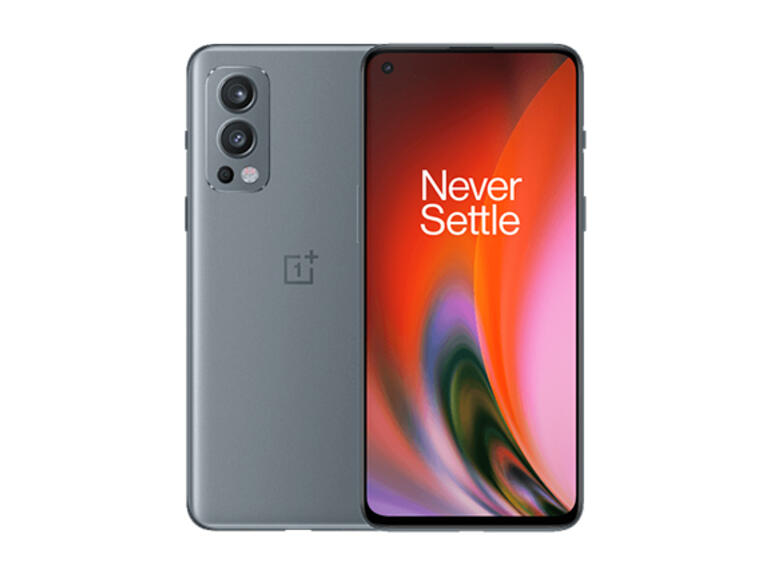OnePlus launched its first Nord handset just a year ago, and since then we’ve seen the Nord N100, N10 5G and, most recently, the Nord CE 5G offer various takes on the middle-to-lower reaches of the smartphone market.
The new Nord 2 5G is the first OnePlus handset to eschew Qualcomm’s mobile platforms, running instead on a MediaTek Dimensity 1200-AI system-on-chip (SoC). It’s also the first handset to appear following the announcement of ‘further integration’ between OnePlus and Oppo, which are both owned by BBK Electronics.
There are two versions of the Nord 2 5G available in the UK: £399 (inc. VAT) buys you 8GB of RAM and 128GB of internal storage, while for £469 you get 12GB of RAM and 256GB of storage. My review handset had the top-end specification. The Nord 2 is available in Europe and India, but not in the US or Australia.
OnePlus has done its best to make the Nord 2 look and feel like a premium handset. There’s a bit more bezel below the screen than you might expect from a truly top-end handset, but the front camera pinhole is relatively discreet on the screen’s top left corner. On the bottom there is a USB-C charge slot, a SIM caddy and one of the phone’s two speakers — the other sits above the screen in the tiny earpiece grille.
The SIM caddy will accommodate two 5G SIMs, which is rare and good to see. You can’t use one of the SIM slots for MicroSD storage expansion, though. My £469 review unit had 256GB of internal storage, of which 12GB was used, leaving 244GB free.
The left edge has a volume rocker, while the right side houses the power button and the useful Alert Slider. When OnePlus leaves Alert Slider out, as it did with the Nord CE 5G, it does itself a significant disservice, as it’s a key hardware differentiator for the company, allowing users to switch between ring, vibrate and silent modes with no fuss. When I use other handsets, I really notice the irritation factor in switching ring status.
Many handsets continue to include a 3.5mm headset jack, so there’s clearly a market for it. OnePlus doesn’t hold to that view, however. There’s no IP rating for dust and water resistance either.
The backplate is Gorilla Glass 5, and it is very slippery. Even sitting still on a pile of papers on my desk that was resting at a tilt was a challenge for it. The duck-egg blue of my review handset (officially, Blue Haze) was a little pastel for my liking, but some will find it pleasing. The Nord 2 is also available in a more neutral Gray Sierra colour. The camera array sits in a significantly raised lozenge on the upper left of the back edge as you look at it, and the handset rocks and clatters on a desk when the upper left quadrant of the screen is pressed.
The Nord 2 measures 73.31mm wide by 159.12mm tall by 8.25mm thick, and weighs 189g. Nothing unusual there for a 6.43-inch handset.
The AMOLED screen is bright and sharp, with good readability thanks to its 2,400-by-1,080-pixel resolution (410ppi). Scrolling and video watching benefits from the panel’s 90Hz refresh rate, which you must specifically select over 60Hz in settings.
The speakers push out plenty of volume but begin to distort about two-thirds of the way up the scale, and I wouldn’t want to use them at full blast unless I had to. Bass is almost non-existent, and audio generally has a very tinny quality. The audio subsystem handles spoken word output a lot better than music.
In-screen fingerprint login and face login both work well. Among the new features for OnePlus is Quick launch, which is built into the fingerprint reader. When you’re logging in, just slide a finger to an icon and the app or function associated with it will launch. It’s an simple idea, but very effective.
Reading Mode seems to have disappeared, which is a shame. This greyscale-screen option, which can be set to kick in when using specific apps, is something I’ve appreciated on previous OnePlus handsets. There’s still a greyscale option, but this is now part of Bedtime mode, which can be set to kick in on a schedule or run manually, rather than associated with particular apps. If the loss of Reading Mode is part of the marriage of OxygenOS (version 11.3 here) and Oppo’s ColorOS, then I’d like to put in a plea for its reinstatement.
OnePlus has publicised its use of the MediaTek Dimensity 1200-AI SoC, an AI-enhanced version of the standard Dimensity 1200, which represents the company’s first move away from Qualcomm and is a result of the new alignment with Oppo. The Dimensity 1200 is a capable platform that delivers impressive benchmarks – the Nord 2’s Geekbench 5 CPU scores were 733 (single core) and 2517 (multi-core). By comparison, Samsung’s £349 Galaxy A52, which runs on Qualcomm’s Snapdragon 720G, turned in scores of 642 and 1659.
There are three cameras at the back, and one at the front. The front camera has a 32MP sensor and an f/2.45 lens, and is fine for selfie snaps. The main rear camera has a 50MP Sony IMX766 sensor and an f/1.88 wide-angle lens with OIS (Optical Image Stabilisation). This is complemented by an 8MP f/2.2 ultra-wide-angle (119.7°) camera and a 2MP f/2.4 mono camera. A Dual View Video feature lets you record video with the front and rear cameras at the same time.
With an AI element for ‘scene enhancement’ and HDR there are plenty of ways to add vibrancy to the colours of images, and what does and doesn’t work well may be as much a matter of personal taste as anything else. Sometimes the natural look is definitely best, and the AI mode tends to apply overly rich colour to images, which to my eyes looks cartoonish.
Limited testing of the Nightscape Ultra mode has so far produced some interesting results that, unlike photos taken with many handsets, I’d be prepared to share with family and friends.
The Nord 2’s 4500mAh battery lasted for 15 hours 54 minutes under the PCMark for Android Work 3.0 battery life test. In my test, it lost 17% from a full charge after streaming three hours of YouTube video, which if continued at that rate suggests battery life of over 17 hours. Either way, battery life is impressive.
Where this handset really shines, though, is in its fast charge capability. OnePlus says that its Warp Charge 65 will take the battery from zero to 65% in 15 minutes. Fast charging slows down as the battery gets fuller, and in a typical test I started charging with the battery at 19%. After 15 minutes the handset was at 76%, and it was fully charged after a further 15 minutes. There’s no wireless charging, but that’s not unusual for a mid-range handse
Conclusions
OnePlus continues to plough the mid-range 5G smartphone furrow with the Nord 2, to impressive effect. It’s nice to see two 5G SIMs supported, and the fast charging works well. There’s room for improvement as far as the speakers are concerned, and it’s a pity you can’t add more storage via MicroSD. And on a personal note, I miss the Reading Mode.




